|
TRANSLATE THIS ARTICLE
Integral World: Exploring Theories of Everything
An independent forum for a critical discussion of the integral philosophy of Ken Wilber
H.B. Augustine (c. 1990) is an author, entrepreneur and activist. He has practiced integral spirituality and philosophy since 2007 and has written, edited, and published several books pseudonymously.
SEE MORE ESSAYS WRITTEN BY H. B. AUGUSTINE Hindu and Greek DeitiesAn Explanation for the Definite Connection between themH.B. AugustineThe following essay was my semester research paper for an Introduction to Hinduism class that I recently took. Naturally, the language and structure is in accordance with the academic circumstances that I faced. Still, I believe that it makes a valid contribution relative to Integral discussion in that it explains how Purple/Magenta/Tribal/Magic consciousness and Blue/Amber/Traditional/Mythic consciousness contain partial truth and value. 1. Introductory WordsWith this paper I am to show something made of two things, one of which easier to accept than its counterpart. I am first to show that there is certainly a definite connection between Vedic (“Hindu”) and Hellenic (“Greek”) major deities. I am then to take this definite connection as a principle from which to deduce something that I believe could possibly follow. I already concede that this second item may be far more ambitious than the first, but I wish for its mere scholarly introduction to remain rightfully between the extremes of specification and speculation. The possibility, then, is this: that the reason why such a definite connection between major deities from apparently unrelated and distinct sociocultural systems exists is that deities as such are projections and illustrations of the human psyche, though perhaps “disowned” and existing as what C.G. Jung calls “Shadow,” comprised of all the parts about oneself that have been fragmented – which could even encompass Jung's “collective unconscious.” The ultimate significance of my work here is that, in light of studying Hinduism, in consideration of its mark as the oldest religious tradition on this planet, in regards to its pantheon of over 330 million deities, and in view of the stated explanation for the definite connection between Hindu and Greek deities, perhaps an even more speculative implication arises: that the Hindu pantheon – along with the whole deistic pantheon spanning all traditions – is actually in accordance with Jung's collective unconscious and perhaps even Plato's intelligible realm of forms. With everything said, I will now begin this scholarly exploration initially by showing that the first part of my thesis is true – that there is a definite connection between these two traditions. I will approach this first section first by reviewing the context underlying both systems, then by more tangibly scrutinizing the relationship between Indra and Zeus, Yama and Hades, Saraswati and Athena, Shiva and Aries, as well as Lakshmi and Hera, in order to support my claim using firm inductive reasoning. After seeing the definition connection, I will move to expound upon the explanation that follows. Let this discussion proceed now by specifically reviewing the contexts underlying both mythological systems. 2. The Definite Connectiona. ContextThe Vedic period began when the Aryans migrated into India, bringing with them their own culture and customs – including the Rig Veda, Sama Veda, Yajur Veda and Atharva Veda, and the caste system (“Ancient History of India”). The Rig Veda begins by both acknowledging and addressing all the gods, or pantheon – that they are all great, that they are praiseworthy, and that they are protectors and providers (8.30). These figures are “magicians” because their power and identity is such that it appears “magical” (10.77). The language characterizing the Vedic period and its beginning indicates a strong idolization of and dependence upon the gods for survival alone (Fein). The pantheon as a whole is significantly diverse, in all ways. Perhaps this diversity is best represented by the triad existence between Brahma, Vishnu, and Shiva as the Three Faces of God's Masculine Form. There is the Creator, on one extreme, there is the Destroyer, on another, and there is the Sustainer, pervading both and all. This initial “diversity” marking the triad becomes a major diversity marked by the 330 million Faces of God that celestially deduce from this initial triadic Principle (“Gods of India”). Although there certainly are not such a number of Greek deities, there definitely are remarkably similar ones – despite the differing culture and location. Of course, there looms the possibility of a common civilizational ancestor between the two cultures (“A Tribute to Hinduism”). Regardless of this possibility, the Greek pantheon relates to the Hindu pantheon first in that it is a pantheon, and second in that this pantheon manifests itself in the form of stories and myths passed down, a family tree of gods and goddesses, and the celestial feel accompanying the Olympian gods, titans, heroes, myths, creatures, and other gods (“Greek Mythology”). The reality for someone living at this time, conditioned by that culture, would be one that today, modernity “knowingly” places within the realms of “fantasy” and “make-believe,” the content sole property to material objects and events exclusively, e.g. books, stories, or films. This worldview perceives reality as composed of “personal,” “powerful,” “magical” forces that govern the entire Kosmos (Beck). Perhaps both traditions honor the same supposed forces, except use different names and deities to represent them. If the latter statement were true, then one can identify five strong connections (at least) between the two systems and deities within them. These strong connections together present the definite connection between them as systemic wholes – which begs the question of how to account for this liaison aside from the possibility of a common civilizational ancestor. The remainder of this section, then, will be to see the plainly intuitive similarity illustrating the relationship between all five pairs of Hindu-Greek deities – beginning with Indra and Zeus.
b. Indra and ZeusIndra is king of the gods and heavens. One of his trademarks is the “Vaijra” or lightning bolt, representing immense power and influence (“The Hindu God Indra”). He is “yellow” in appearance because of his drinking Soma (“Hymn XXXII”), an especially potent intoxicating drink of which “yellowness” is not only predicative but also rather symbolic. Aside from color, Indra is associated with rain, wind, and storms (“Hinduism: Characteristics and Attributes of Indra”). He performs “heroic deeds” (Rig Veda 139), but he also does things to the contrary, such as chastising his own son and having bad relations with family in general (10.28). Nonetheless, Indra “[protects] the gods with his power of thought” and, in general or even in “essence,” is characterized significantly as power (2.12). 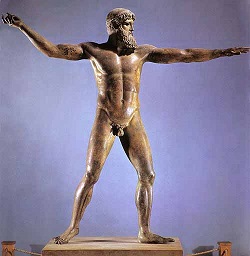
Zeus, too, is a weather god. The name “Zeus” relates to the Greek word dios for “bright.” If being bright means having authority, then the name for this god holds true since he is indeed King of the Olympians and master of justice and order (“Zeus”). He is “affirmed with thunder and lightning,” the lightning bolt as his primary weapon (“Zeus 2”). Also like Indra, Zeus does not have optimal familial relations, having to overthrow his father, Cronus, and kill several other family members (“Zeus 3”). The relation between these two deities, then, should appear simple. Both symbolize, and are, power and authority, above all. The next strong connection to identify is that between Yama and Hades.
c. Yama and Hades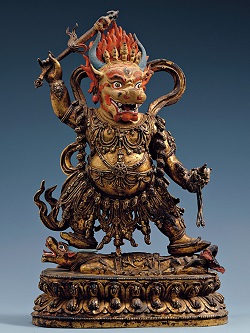
Yama is the lord of death, guardian of the “south” or “abode of the dead” (“Yama”). He lives in an underworld palace called “Kalichi,” and follows predestination while being able to bring death to anyone at will. Yama chooses to follow predestination, and dharma, and not to go out of sync with it (“Yama 2”). The name “Yama” itself means “restrainer” (“Yama: Forerunner, First Mortal, God of Death”), restraining humans from being corporeally immortal. The Rig Veda states that he is the first son of the sun and the first mortal man (10.10). Despite the cosmic role that he plays as guardian of the south, he is not immoral because of his strict adherence to dharma and order. For instance, Yama refuses to mate with his sister, Yami, based upon moral principle, despite her insistence that doing so is necessary for the sake of procreation (10.15-22). Interestingly, he is associated with the planet Pluto, which is the alternative name of Yama's Greek counterpart, Hades (“Yama (Hindu God)”). 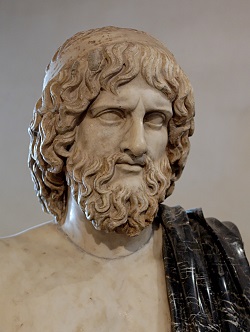
Hades is king of the underworld, also known as “Pluton” or “king of the shades” (Atsma). He is brothers with Zeus and Poseidon, who together had to reconcile which one of them would rule which world, following the death of Cronus. With his power, Zeus took the sky and gave Poseidon the sea, which left Hades with the underworld. Because of his role as king of this realm, he is very rich, having access to all the world's precious minerals. Along with this wealth, Hades is greedy and desires to have more subjects, more souls to claim (“Hades”). “The Rich One,” as he is also known, is liked least amongst all the Greek deities because of his negativity and vice (Lindemans). Although Hades may not seem nearly as similar to Yama as Zeus to Indra, both 1) definitely relate in their overseeing the underworld or realm of death and 2) potentially do not relate in that Indra exemplifies “Death” in sync with dharma, while Hades exemplifies Death out of sync with dharma (or in language of that context, “virtue”). Now consider the strong connection between Saraswati and Athena.
d. Saraswati and Athena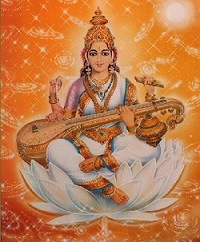
Saraswati is one of four aspects comprising the Divine Mother, which complements the three aspects comprising the Divine Father that is Brahma-Vishnu-Shiva. She is a “cosmic musician,” embodying perfection, knowledge, and wisdom. Saraswati is also a hero to and for the people, demonstrating both courage and wit, in addition to rhyme and reason (“Maha Saraswati”). King Navaratha praises her for being pure and wise, for being the “womb of the world, the excellent Yogini, the supreme spouse of the Golden Embryo, the third-eyed, moon-topped goddess!” (Dimmitt 241).
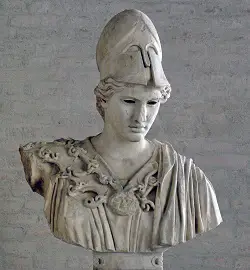
Athena relates to Saraswati in the significance behind her symbolization as or avatar of the owl – watchful and wise. Athena, in short, is very intelligent (Regula). She is heroic in character since she is the goddess of war. For instance, she actively participates in the Trojan War, by virtue of this relating to her duty as a deity (“Athene”). Both goddesses strongly relate in that they represent the feminine empowered by wisdom, courage, and heroism. Perhaps both of these deities, and the “essence” that they share, offer a perfect model for any feminist. Regardless of the latter speculation, there remains the strong connection between both figures. Let us continue by examining the subtle link between Shiva and Ares.
e. Shiva and Aries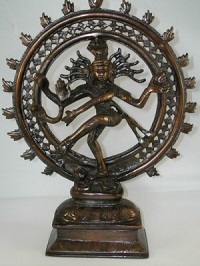
Shiva is perhaps one of the more complex Hindu deities. His name means “auspicious,” though his persona is just as ambiguous in flavor as it is auspicious (Dimmitt 148). An example of such ambiguity is that Shiva is both “self-controlled and celibate, while at the same time a lover of his spouse.” The god is supremely powerful, but he is not distinguished most because of his power, but because of his role as the Destroyer, including both positive and negative forms of destruction. Shiva's power to destroy comes from his energy that is simultaneously his wife, Shakti – which is an “explosive” kind of energy. Symbolically, he is associated with the tiger, as he sits on its skin (Gruenwald). This animal, along with the elephant, shows his ability to “control and transform animal nature” (Jayaram). Alongside this ability are Shiva's main weapons, his bow and club, as well as serpent (Kishore 8-9). 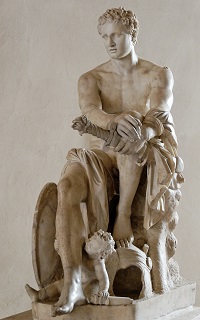
The deity is also associated frequently with Agni, the fire god, because Shiva rides on a bull, and Agni is often symbolized as the bull. This association makes sense because of what fire does – it consumes, it destroys in a fierce, passionate manner (“Mantras for Lord Shiva”). Like fire, Shiva destroys everything that needs to be destroyed, with the guiding aim of Brahma creating something new in place (Das). Shiva's symbolism as fire is also suggestive of his relationship to Ares, the Greek god of war and action, “battlelust and courage,” “bold force and strength” (“Ares”). Fire symbolizes drive, and it definitely can symbolize “battlelust,” “lust” in general, or “passion.” Shiva indeed contains such passion, described as loving and making love to Shakti for days sometimes; in fact, tantric sexual doctrine emphasizes “Shiva-Shakti” cultivation (“The Divine Couple Shiva-Shakti”). I will admit that the connection between Shiva and Ares is not as strong as ones already discussed, but the symbolic relation between war, fire, and destruction is still quite noteworthy. Let us now consider the fifth and final strong connection between these two traditions, before analyzing the significance. This pair involves Lakshmi and Hera.
f. Lakshmi and Hera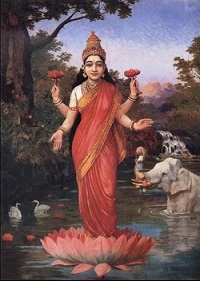
Lakshmi is the Hindu goddess of wealth and prosperity. Along with Saraswati, she is one of the Four Faces of the Divine Mother. The name stems from “laksme,” which means “goal.” Lakshmi represents the goal of life, enjoying wealth and prosperity that results not from attachment to such, but from dedication to dharma. Lakshmi is indeed worthy of being spouse to the perfect and righteous Vishnu. The number four is significant to this goddess for a number of reasons, one of which being her four arms (“Goddess Lakshmi”). Perhaps this number is rather fitting, at least relative to the perspective of numerology, in which four is the most “natural” number. If “natural” denotes the manifest, material universe, then the number is doubtless fitting for this deity. 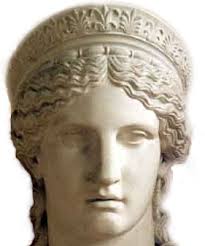
Lakshmi represents the material or phenomenal side of existence, which complements the mystical or spiritual side (represented by Vishnu) (Dimmitt 99). She “represents the beautiful and bountiful aspect of nature” (“Lakshmi the Hindu Goddess of Wealth”). Gold coins fall from her hands everywhere she walks, blessing all with wealth (“Lakshmi”). Hera immediately relates to Lakshmi in that she is married to Zeus, and together they rule the gods and goddesses. She holds a position of privilege and power, affluence and fortune. She also represents women and marriage (“Hera”). These two aspects of Hera connect her with Lakshmi: 1) her wealth and fortune, and 2) her divine femininity.
g. ReflectionsAs evidenced by the stated five strong examples, we scholars can certainly draw comprehensive parallels between the Hindu and Greek mythological traditions. Perhaps these two cultures one-third around the world from each other do in fact share a common civilizational ancestor, and that is primarily why such strong connections exist. Yet for the sake of this work staying more along the lines of “religion” than along those of “history,” pretend that there is no such common link, that the peoples of Greece never once interacted with the peoples of India. Logically, I cannot avoid the binary that follows, which is this: that there is some partial truth or meaning behind why the deities are so similar, or there is none. I am far more inclined to believe that the former possibility is true. Therefore, with the remainder of this paper, I will explore the possibility that the definite connection is 1) meaningful and 2) not related to any original civilization (aside from how likely evidence suggests this to be). If the cause for this meaningful relationship is not physical and does not involve oppressor imposing its beliefs on oppressed, then the cause must be psychological. Not only does a psychological cause seem plausible, but also the notions of “psychology” and “psyche” themselves share an intimate relationship with religion itself – and, after all, the subject of this course is just that. Jung would agree that such a relationship between the two exists, just as why he would maintain that the definite connection between Hindu and Greek mythology exists. I believe that Jung's theories of the Shadow and collective unconscious fit neatly with the explanation that I am to propose. In making this proposal while at length concluding the paper, I will draw upon relevant textual material that engages in dialogue about these concepts, while then doing my best to demonstrate their synthesis.
3. A Plausible Explanation
For Jung, an entirely distinct “realm” or “dimension” exists that is nonphysical in its nature. He calls it the collective unconscious, which contains all ideas, symbols, and concepts that correspond to the world that we sensibly experience. These ideas, symbols, and concepts can be denoted by the term “archetype.” Archetypes are the “collective universal patterns or motifs which come from the collective unconscious and are the basic content of religions, mythologies, legends, and fairytales” (Ward). A person's ultimate identity, then, is not the name or idea that he or she constantly entertains, but is rather the collective unconscious (and its source) itself: “In addition to our immediate consciousness, which is of a thoroughly personal nature and which we believe to be the only empirical psyche, there exists a second psychic system of a collective, universal, and impersonal nature which is identical in all individuals” (Jung 43). He claims that this assertion is no bolder than to state that there are “instincts” (Jung 44). Being in the world causes us to disown identification with such a plurality of archetypes. One clings to some ideas or labels, but one also unconsciously rejects many. The archetypes comprising the collective unconscious are “categories of the imagination” (Jung 43). One such category might be the idea of a “second birth,” which is prevalent throughout nearly all cultures and mythologies spanning history (Jung 45). An archetype, however, is not just a static spiritual entity that exists in abstraction – rather, it has autonomy of its own (Jung 40). The totality of archetypes that one has disowned or neglected has a singular autonomy itself. This totality of disowned archetypes, for Jung, is the Shadow. The Shadow, then, is the unconscious, and is constantly at war with the conscious – because it, too, carries autonomy. Oftentimes, though, the autonomy of the Shadow exceeds the power of the conscious mind, and so that individual lives like a slave to the Shadow within a self-created hell. The way that Jung advices someone to overcome the Shadow is through merging it with the light, with the conscious. People, unfortunately, experience a great deal of fear about becoming (more) conscious of themselves (Jung 14). Zen Master Genpo Roshi, discoverer of the “Big Mind” vehicle in Buddhism, synthesizes Jungian principles with Zen practice. According to Ken Wilber (who many scholars have called the “Einstein of consciousness”),
The Big Mind Process founded by Zen Master Genpo Merzel is arguably the most important and original discovery in the last two centuries of Buddhism. It is an astonishingly original, profound, and effective path for waking up, or seeing one's True Nature.
According to Roshi himself, the finite or limited self, or what one calls “I” or “me,” is not some singular unit, but is more like a company made of a complex structure involving many employees, each of whom having a distinct function for the benefit of that self (“Carl Jung”; “H.B. Augustine”; “Lyone Fein”). Roshi sees as Jung in that the company that is the self becomes disrupted throughout life, creating imbalance within its psychological structure. Some aspects of the personality become fragmented and forgotten about, while others emphasized too much. Using Big Mind language, an example of the latter statement might be that someone has disowned “Wisdom” and identifies as “Anger.” The individual must reintegrate with Wisdom while let go of Anger and stop repressing it (too). “Wisdom” and “Anger” are both legitimate aspects of the personality, components of the self, employees of the company. Sometimes, wisdom – or knowing what is right and true – is necessary and valuable. Sometimes, anger – or feeling an intense frustration – is necessary and valuable. Through this process, practitioners engage in self-dialogue between these archetypes, gradually activating ones that had been previously disowned, and in doing so, both healing and growing psychologically (and spiritually, according to Roshi) like never before (Roshi). With the information on Jung and Roshi in mind, we now have a sufficient intellectual grasp to see how it all relates to the definite Hindu-Greek deity connection(s). I can identify two main possibilities that follow. The first is less speculative and more acceptable, perhaps, than is the second. With these ideas considered, the first is this: that the existence of gods, goddesses, and deities as such is unconsciously created by humans' projecting elements of their Shadow onto mythopoetic figures. The second is that such a collective unconscious exists and hence gives rise to a “Pantheon,” upon which all similar mythologies would be drawing. Expanding upon the first possibility, I believe that having examined Jung's ideas, the psychological reason behind deities' existence is surely a human projection. Using Big Mind language in relation to the latter statement, this means that Indra/Zeus is a projection of, say, “Autonomy,” and Saraswati/Athena of “Feminine Strength.” The name ultimately does not matter – what matters is the reality of what this name represents, which here is an element of the human psyche that is shared between two presumably independent cultures. This first possibility leaves us with seeing that there may be “psychological organs” (just like bodily organs) that all humans inherently share, regardless of birth. Clearly, such organs (may) have played a role in shaping religious text. Now expanding upon the second possibility, I believe that if we try to comprehend the “whole picture” in this case, then we will not be able to deny that there must be a collective unconscious, which symbolically manifests itself as a Pantheon that the Vedic and Hellenic traditions have interpreted through the filter of their own culture, their own innermythology, language, problems – everything. The notion of this collective unconscious ties in with those of the pantheon, the forms, and even the esoteric tradition of astrology. What is the significance of there being 330 million Hindu deities? Why did “the ancient Greeks [use] a deity to mirror every state and capacity, every mood, thought, act, and experience of the human being?” (Ward). The answer to these questions may be that the collective celestiality of deities is but a different expression of or name for the collective unconscious of archetypes – which would explain why the Hindu pantheon deduces from one, to two, to three and four, and so forth, all the way down. The celestial web of deities, the unconscious realm of archetypes, might also be compared to Plato's intelligible world of forms, to which the psyche has access, and which exist as pure ideas corresponding to their terrestrial manifestations (“Plato”). Perhaps even astrology is of relevance here in that planetary alignments are in fact meaningfully synced with major historical events, which suggests some correlation between the planets and people (Tarnas). Perhaps each planet both represents and contains a sort of “subtle energy” that current technology has not yet mapped – an energy that connects to Earth from each planet like veins to a vital organ. Perhaps yet, the deities, gods, goddesses, archetypes, forms, and/or ideas are all simply as Campbell describes – “Eternal Ones of the Dream” (The Hero with a Thousand Faces 14). In summary, this paper has explored the definite connection posited between five Hindu and Greek deities, along with an explanation for it based on the relationship between the psychological creation/depiction of mythology and the reality of a Shadow and collective unconscious. A less ambitious outcome from this assertion is that such is true, but only inasmuch as it is true that the human psyche or mind is inherently divided categorically, just as the body is. A more ambitious outcome – however – is that there not only exists a collective unconscious, but that this domain also directly pertains to a Pantheon that is a collective unconscious in which each archetype symbolically and actually exists as a deity, and that the existence of this domain has given rise to the rich diversity of pantheons marking religious historical development across the globe. Regardless of which possibility(s) the reader chooses to consider, accept, reject, or embrace, what remains is that there must be immense significance to a religion's pantheon equaling in number little less than the total United States population.
4. Works Cited"Yama: Forerunner, First Mortal, God of Death." IndiaYogi. Web. 2 Dec. 2010. "Lakshmi the Hindu Goddess of Wealth." Buddha Statues, Hindu Statue, Hindu Gods, Shiva Ganesh, God Statue, Om. Web. 10 Dec. 2010. "Ancient History of India." India Guide - Culture, Facts, Lifestyle, Cars, Bikes, Art & Entertainment. Web. 8 Dec. 2010. "Ares." THEOI GREEK MYTHOLOGY, Exploring Mythology & the Greek Gods in Classical Literature & Art. Web. 10 Dec. 2010. "Athene." THEOI GREEK MYTHOLOGY, Exploring Mythology & the Greek Gods in Classical Literature & Art. Web. 10 Dec. 2010. Atsma, Aaron. "Haides." Theoi Project. Web. 25 Nov. 2010. Beck, Don. "About Spiral Dynamics Integral | Spiral Dynamics Integral (SDi)." Spiral Dynamics Integral (SDi). Web. 10 Dec. 2010. Campbell, Joseph. The Hero with A Thousand Faces. 2nd ed. Princeton, N.J.: Princeton University Press, 1972. Print. Das, Subhamoy. "About Lord Shiva: The Fascinating Deity." About Hinduism - What You Need to Know About Hinduism. Web. 7 Dec. 2010. Dimmitt, Cornelia, and J. A.B. van Buitenen. Classical Hindu Mythology: A Reader in the Sanskrit Purāṇas. Philadelphia: Temple University Press, 1978. Print. Eliade, Mircea. Myth and Reality. Prospect Heights, Illinois: Waveland Press, 1998. Print. Elliot, Sir Charles. "A Tribute to Hinduism." Hindu Wisdom. Web. 9 Dec. 2010. Fein, Lyone. Notes. Flaherty, Wendy Doniger. The Rig Veda: An Anthology: One Hundred and Eight Hymns. Harmondsworth: Penguin Books, 2007. Print. "Goddess Lakshmi." Kashmir Hindu Deities. Web. 3 Dec. 2010. "Gods of India." Angelfire. Web. 8 Dec. 2010. "Greek Mythology." Greek Mythology. com. Web. 7 Dec. 2010. Gruenwald, Christine. "The Hindu God Indra." Sanatan Society. Web. 10 Dec. 2010. "Hades." Greek Mythology. Web. 11 Dec. 2010. "Hera." THEOI GREEK MYTHOLOGY, Exploring Mythology & the Greek Gods in Classical Literature & Art. Web. 10 Dec. 2010. "Hindu God Shiva: Shiva (Shiv) - the Destroyer." Sanatan Society. Web. 2 Dec. 2010. Hindu Gods and Goddesses. Mylapore: Sri Ramakrishna Math, 19871997. Print. "Hymn XXXII." Internet Sacred Text Archive Home. Web. 15 Nov. 2010. Jung, C. G. Psychology and Religion. New Haven: Yale University Press, 19921938. Print. Jung, C. G., and Anthony Storr. The Essential Jung. [Updated ed. Princeton, N.J.: Princeton University Press, 19971983. Print. Jung, C.G., and R.F.C. Hull. The Archetypes and the Collective Unconscious. 2nd ed. Princeton, NJ: Princeton University Press, 1990. Print. "Lakshmi." India Guide - Culture, Facts, Lifestyle, Cars, Bikes, Art & Entertainment. Web. 8 Dec. 2010. Leadbetter, Ron. "Zeus." Encyclopedia Mythica. Web. 5 Dec. 2010. Lindemans, Micha F. "Hades." Encyclopedia Mythica: Mythology, Folklore, and Religion. Web. 9 Dec. 2010. "Maha Saraswati." WriteSpirit. Web. 7 Dec. 2010. "Mantras for Lord Shiva." Free Encyclopedia & Web Portal on Indian Culture & Lifestyle. Web. 28 Nov. 2010. "Plato." Stanford Encyclopedia of Philosophy. Web. 2 Dec. 2010. Puhvel, Jaan. Comparative Mythology. John Hopkins Paperbacks ed. Baltimore: Johns Hopkins University Press, 19891987. Print. Regula, deTraci. "The Greek Goddess Athena - Fast Facts on Athena - Greek Mythology - Athene." Greece Travel - Travel to Greece and the Greek Islands. Web. 6 Dec. 2010. Richardson, Adele, and Laurel Bowman. Hades. Mankato, Minn.: Capstone Press, 2003. Print. Roshi, Genpo. "Home." Big Mind. Web. 5 Dec. 2010. Sanyal, Sumanta. "Yama 2." Encyclopedia Mythica: Mythology, Folklore, and Religion. Web. 2 Dec. 2010. Simon, Belinda. "Hinduism: Characteristics and Attributes of Indra ." Helium - Where Knowledge Rules. Web. 12 Nov. 2010. "THE DIVINE COUPLE SHIVA-SHAKTI." Hatha Yoga Tantra Yoga Meditation Music. Web. 7 Dec. 2010. Tarnas, Richard. "Cosmos and Psyche: Intimations of a New World View." Cosmos and Psyche: Intimations of a New World View. Web. 10 Dec. 2010. Uchtman, William. "Yama (Hindu God)." Yama. Web. 5 Dec. 2010. V, Jayaram. "Aspects of Siva." Hinduism, Buddhism, Jainism, Sikhism, Zoroastrianism and Other Resources. Web. 8 Dec. 2010. Ward, Dan. "Archetypes." The Library of Halexandriah. Web. 6 Dec. 2010. "Yama." Encyclopedia - Britannica Online Encyclopedia. Web. 27 Nov. 2010. "Zeus 2." THEOI GREEK MYTHOLOGY, Exploring Mythology & the Greek Gods in Classical Literature & Art. Web. 10 Dec. 2010. "Zeus 3." Greek Mythology. Web. 4 Dec. 2010. |